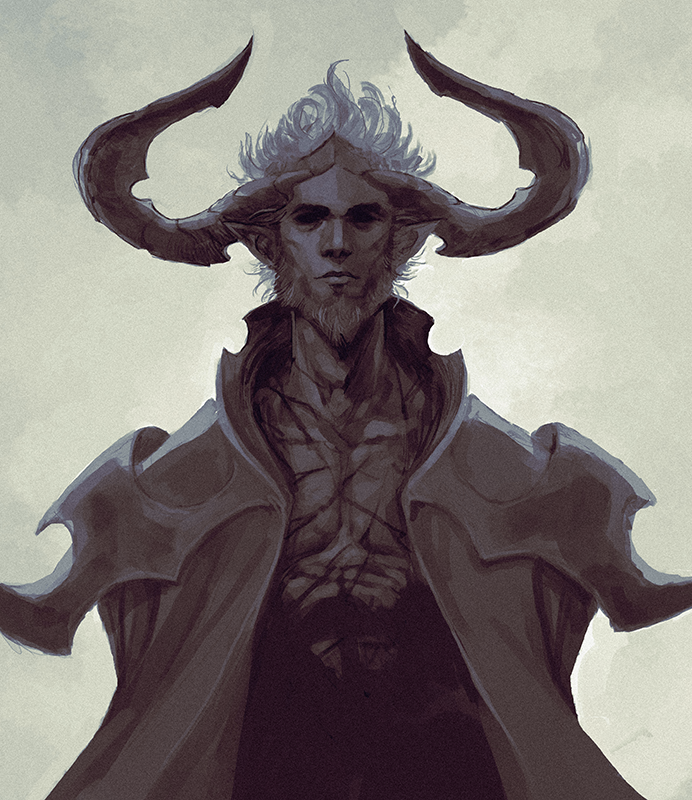
We’ve previously discussed:
- The continuity errors in Lulu’s backstory.
- The continuity errors in Zariel’s backstory (including seeking vengeance against a Demon Lord of the Abyss by attacking the Nine Hells).
- The failure to pay off the rediscovery of Lulu’s memories after positioning them as THE central mystery of the second half of the campaign.
- That many of the tools given to the DM for managing Lulu’s memories are conceptually great (like a list of memory triggers and a definitive reference for her backstory), but unfortunately flawed and incomplete (i.e., giving a “definitive” reference that has both continuity errors and glaring omissions).
I’ve also briefly talked about my dissatisfaction with placing the Charge of the Hellriders in 1354 DR despite the fact that it was already legendary and of uncertain truth in 1358 DR. (This is definitely a non-essential fix. But, yes, I’ll be fixing it.)
In this installment of the Remix, we’re also going to be looking at Lulu’s dream quest and the other “memory dives” in the campaign.
One of the potential problems with Descent Into Avernus is that the PCs lack any sort of personal relationship with Zariel. She is, at best, a distant antagonist. Despite this, at the end of the campaign, the PCs are assumed to come face-to-face with her for the first time and immediately help her redeem her soul. This makes it really difficult to get the players emotionally invested in Zariel’s ultimate fate.
This is what makes the idea of Lulu’s dream quest so awesome! The PCs can actually experience the Charge of the Hellriders, the fall of Zariel, and all this other cool history the campaign is built around. They may not actually meet Zariel, but they’ll nonetheless get a chance to know her and, therefore, care about her.
… except the dream quest doesn’t actually do that. The dive into Lulu’s “memories” are structured around five “dreams”:
- Dream 1: Explicitly something that didn’t actually happen.
- Dream 2: Didn’t happen and isn’t a memory.
- Dream 3: Actually just part of Dream 2.
- Dream 4: Not a memory.
- Dream 5: Lulu looks through a telescope and sees where the Sword is (except she doesn’t, actually).
This is a huge missed opportunity!
Dream sequences often all flat because they aren’t real and don’t mean anything. But they can be really amazing if they ARE meaningful and have real stakes. Which is absolutely the case with Lulu’s dream quest: Her memories are the central mystery of the campaign, right? And at stake is the location of the Sword of Zariel, which is the key to saving an entire city. Insofar as the players give a crap about this campaign, they will give a crap about what is revealed here.
Which is why it’s so frustrating that literally nothing is revealed.
So we’ll also be looking at how to structure these memory dives to provide a compelling “memory mystery” that delivers meaning and memorable pay-offs (pun intended). In fact, we’ll be adding a couple new memory dives to further enhance this portion of the campaign.
DEFINITIVE HISTORY OF ZARIEL & LULU
This is designed to be a broad, authoritative overview of the back story for Zariel and Lulu. You can assume that any place this reference contradicts the book-as-published that the change is deliberate.
THE AVERNIAD
- Aeons ago, when the cosmos was still young and the Great Wheel had not been fully turned from the primordial planar chaos, Zariel fought in the Legions of Heaven. She served under the command of Ashmedai, a Celestial Marshal who rode a golden, winged lion.
- Ashmedai and his legions were sent to Avernus. At this time, Avernus was a paradisical plane. Elysium and the Seven Heavens both desired to add it to their realms, and so their armies clashed upon its emerald plains.
- The full tale of the Averniad is beyond the scope of our discussion today. (There are some who claim the full complexities of the celestial epic cannot be told in the course of a single mortal lifetime.) The important bit comes at the end: In the Great Betrayal, Ashmedai wrenched Avernus from the grasp of both Mt. Celestia and Elysium, instead claiming it for himself and aligning it with the Eight Hells. Thus Avernus became the Ninth Hell.
- Ashmedai’s legions schismed between those who remained loyal to him and those who remained loyal to Mount Celestia. Ashmedai himself became Asmodeus, and his legion of fallen angels, using Avernus as a staging base, conquered Hell, wresting its crown from the brow of the dark lord Ahriman.
- Zariel’s Long March: During the Fall of Avernus, Zariel’s commander – an angel named Chazaqiel – followed Asmodeus. Zariel and a small band of angels loyal to Heaven broke away and began a long march across Avernus before finally escaping down the River Styx (which in those days followed a very different course).
MEETING LULU: Her experiences during the Fall of Avernus had tainted Zariel’s mind with bitterness and anger. While recuperating within the starry groves of Lunia, Zariel met and befriended Lulu, a hollyphant who called the silvered forests of that plane home. When Zariel’s soul found peace and returned to Heaven’s legions, Lulu accompanied her as both friend and warmount.
THE TRIAL OF ASMODEUS
- Long after the events related in the Averniad, a heavenly strike force penetrated Hell and captured Asmodeus, bringing him back to Mount Celestia to answer for his crimes. (There are some who believe that Asmodeus allowed himself to be captured, knowing what would happen next.)
- Asmodeus claimed rights under the Pact Primeval. Also known as the First Law and quite possibly the first legal code to ever exist, it had been a founding agreement among the first Planes of Law that had emerged out of primordial chaos (and later became the Seven Heavens and Mechanus). Other pacts, such as those between Celestia, Elysium, and Olympus, had been based upon the authority of the Pact Primeval. By the time Asmodeus made his appeal, the Pact had been supplanted by other codes, but most of those codes ultimately still derived their legal standing from the Pact itself. Therefore, Asmodeus’ appeal to the Pact could not be ignored.
 Thus began the Trial of Asmodeus. Primus of the modrons was appointed as a neutral arbiter and judge.
Thus began the Trial of Asmodeus. Primus of the modrons was appointed as a neutral arbiter and judge.- The alleged crimes of Asmodeus, spanning aeons, were limitless. Even the testimony to their effect was seemingly without end, as an angelic horde bore witness, one after another. At last Primus, having grown weary of the proceedings, called a halt to the testimony: The scope of Asmodeus’ illimitable acts had been well-established and their sheer quantity was irrelevant.
- Zariel, who had not yet had the opportunity to testify to the atrocities she had personally witnessed, was outraged. She violently demanded that she be allowed to speak, and when Primus ordered her to be silenced, the altercation sprawled into a brawl which completely disrupted the proceedings. (Was this the moment that Zariel first came to Asmodeus’ attention? Or had he had his eye upon her from the beginning?)
- Asmodeus’ defense was simple: Although his former comrades interpreted his actions as a betrayal, they had not actually violated the principle of the Law. Indeed, they had upheld the Law by preventing an alliance between Hell and the Abyss which might have swept away all other planar powers. The Blood War fought by his devils now safeguarded Law from the Chaos of the Abyss.
- In the end, Asmodeus prevailed. His acts may have been Evil, but Primus ruled that they were ultimately in accord with the Law, and were thus in accord with the Pact Primeval. The law which had once been the bedrock of Heaven now became Asmodeus’ holy right to test the merit of mortal souls (i.e., tempt them to evil) and claim those souls which were Hell’s due. (However, as part of Primus’ ruling, Asmodeus was also bound to always carry the Ruby Rod of Asmodeus, an artifact that both signified Asmodeus’ divine rights, but also bound him – and, through him, the other devils of Hell – to uphold the bargains they made with mortals.)
THE PURSUIT OF YEENOGHU
An almost incalculable amount of time then passed, during which Zariel and Lulu were living an eternal, angelic existence. Zariel remained of a martial temperament, waging war upon the forces of evil.
THE FIRST VISIT TO IDYLLGLEN
- Several centuries ago (we could perhaps say the 8th or 9th century in Dale Reckoning, during the internecine conflicts which resulted in the Fields of the Dead becoming the Fields of the Dead), Zariel became aware that the demonic lord Yeenoghu had invaded the Material Plane and was personally leading a gnoll army that was sacking settlements north of the River Chionthar.
- Zariel and a band of angels journeyed to the Material Plane to put an end to Yeenoghu’s depredations. They caught up with the demon lord in the village of Idyllglen.
THE DAUGHTER OF ASMODEUS
- Zariel’s task force weren’t the only ones hunting Yeenoghu, however. A strike team from Avernus lead by Glasya, daughter of Asmodeus, had also been tracking Yeenoghu. They arrived during the battle and helped rout the demon lord.
- Yeenoghu escaped, but his army was decimated and scattered to the winds. After the battle, there was tension between the celestial and infernal hosts, but Zariel and Glasya spoke for a short while and – having briefly been strange allies in the Blood War against the Abyss – agreed to go their separate ways.












So much more compelling than the lore provided in DIA.
I wonder, where is (was?) Idyllglen located? I don’t recall it being specified in the text.
Might having one of (or all) the PCs be from Idyllglen (if it still exists) be an option? Then they would come with a folk-tale version of the story built in.
@Owen Hendriks: I believe Idyllglen is just stated as being a village in the Fields of the Dead. There’s not fixed location on a map anywhere.
@Owen, sounds like a great idea, bringing Idyllglen in earlier, just like having an actual Hellrider in the party is cool. You’d want to be careful writing the folk-tale version of the lore — ideally I’d think you want to give a slightly different version than the Hellriders have, in a way that raises some mystery early. Consider the revelation lists and see where you can add clues. There’s no intrinsic harm in resolving a revelation “early” as long as it gets replaced with some other question the PCs become invested in.
Extraordinary!
Awesome!
So many Thanx for this wonderful back story of Zariel and Lulu!
It will really make my players much more involved as I will be much more involved as a DM
Thank you so much!
“Zariel, who hadn’t gotten to testify”
The sheer amount of cosmic and mortal history that might have been altered if Primus hadn’t been hearing testimonies in alphabetical order. ‘XD
@Knowlessman: Heresy! Of course Primus did it in alphabetical order. The lawful way. The right way lol